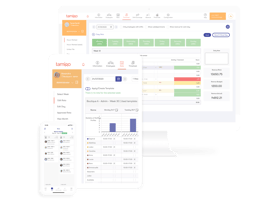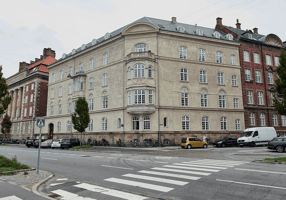In the face of labour shortages and costly inefficiencies, the hotel industry is embracing new ways of working, facilitated through cloud-based solutions.
We gathered three of our tamigo experts, all with extensive experience working with hotel groups and chains in Spain, the Netherlands, France and the Nordics, to discuss this digital transformation.
How are these solutions helping hotels boost retention rates and streamline daily operations? Read on to learn more.
The digital transformation is underway
Over the past few years, we’ve seen an acceleration of a trend that was already in full swing: the investment in cloud-based software.
Covid was one of the main drivers. A period of massive disruption, it spurred businesses to find new efficiences and ways of engaging with a customer base whose priorities had been reshaped.
Hospitality is at the forefront of this digital transformation. From the outside, the upgrades in customer-facing tech are clear — think contactless check-in or pre-arrival customisation. But for those in the industry, the transformation of operations has been just as significant.
The scale, and the duration brought about by the pandemic is leading to a sustained shift in the way travel and hospitality companies plan, manage and operate their businesses.
David Peller, Managing Director, Travel & Hospitality, Amazon Web Services, Inc.
It’s estimated that the hotel and hospitality management software market will grow by USD 1,176.2 million from 2022 to 2027. Europe accounts for 34% of that growth.
The new tech ecosystem needs to benefit everyone
So what are these new ways of working and new software investments?
For larger hotel chains and groups, the tech ecosystem they employ can be vast. There’s PMS, Payroll and HMS to name a few.
Alfonso Franch, tamigo’s Country Manager for Spain, has worked closely with big operators, including Barceló. He’s seen one area where software needs to play a big role — daily operations. Watch below or read transcript.
Transcript (edited for clarity):
“An important trend we are noticing in tamigo, is that headquarters are looking at tools for customers: to do quick checking in, etc. But they also must look at operational tools.
Now in headquarters, they may already have a good ERP system for example, to control things from an HR perspective. But what about the employees on the ground in the hotels? They need technology too.
What we are covering is the gap that exists between headquarter tools like HCM and ERP and the real life that employees are living everyday. So when it comes to managing day to day operations, tamigo is a great fit for hotel chains.”
‘Daily operations’ means different things to different people. After all, a GM’s daily tasks aren’t too similar to those of an employee working the front desk.
The beauty of modern WFM solutions for hotels is that they cater to every role with relevant features. And do so in one shared, cloud-based platform.
For GMs, Hotel Managers and Heads of Departments, top features include data-driven shift plans and accurate timesheets. For regular employees, easy shift swaps and real-time schedules are extremely useful. Those working in HQ can make use of KPI reporting, to get a concrete view over labour costs and staff turnover in every hotel.
Our experts had more to say about workforce management solutions. Let’s dive in.
The role of workforce management (WFM) solutions
There’s lots of reasons why a WFM solution should be at the heart of digital transformations. Our experts highlighted three: better planning with KPIs, improved employee engagement and compliant time and attendance.
Better planning with KPIs
Hoteliers can roughly schedule staff for big seasonal swings. But beyond that, there can be a black hole of data. KPIs help shine a light, by giving shift managers real-time info on reservations, dinner bookings and more as they plan, so they better match demand.
Wouter Lemckert is tamigo’s Country Manager for Netherlands. From his work with brands such as Fletcher Hotels, which operates 110 locations, he’s seen how KPIs result in more efficient schedules. Here’s why:
Transcript (edited for clarity):
“Forecasting is always hard, especially in the hotel business, because on the customer side there’s a lot of flexibility. You can cancel your room the day before for example. But hotels must plan their schedules 1 or 2 weeks upfront. So there's a gap there, meaning it’s very hard to know what to expect.
What we do is interface with all your data: with the PMS system, the F&B and POS system, etc. If I have more check-ins than usual after 3:00, then I need one additional person at the front desk. Or I see 200 guests will be having breakfast. That means that I can put two people on it, but if it's 300 guests, I need to plan differently.
Our customers love these kind of KPIs. The general managers especially, because they can see what their heads of department base their planning on — and if they’re scheduling too few or too many staff.”
What are the most popular KPIs for hotels to use in tamigo? Here’s a few we see our customers relying on:
- Expected PAX. Bookings from your reservation software are imported into tamigo and displayed underneath the planned schedule for your restaurant department. Your Restaurant Manager can then shift plan much more concretely in line with actual bookings.
- Wage percentage. The amount of labour costs compared to revenue. Can be calculated for different departments — for example, for both your restaurant and housekeeping.
- Sales per Total Hours: A critical metric in hospitality, this KPI shows how productive your staff are, which is crucial for setting budgets or benchmarking against industry standards. Sales numbers can be entered manually or imported from your other systems (such as POS).
- Amount of Hours (Under 18): Staff under and above 18 have different contracted hours and responsibilities. This KPI instantly shows planners how they’re splitting the workload between these two groups of employees.
- Staff Turnover: This is the rate of leavers compared to working employees. In an industry experiencing labour shortages, this KPI can set the foundation for targeted employee engagement initiatives (and is also key data to inform your hiring).
Discover more about tamigo’s KPIs and reporting features here.
Improved employee engagement
Ensuring great customer service is a goal for any hotelier. Even just a couple of bad reviews on sites like booking.com can have a big impact.
For this, you need to have satisfied and engaged employees. There’s lots of ways to achieve this (read our article on employee engagement for tips) but empowering them with flexible scheduling needs to be a priority. That’s because Covid made work life balance incredibly important for employees — and lack of it is the number one reason for attrition.
tamigo’s Implementation Specialist Ines Mourão Balsa believes that smarter tools to manage work are key to improving employee engagement. She explains how the tamigo app helps:
Transcript (edited for clarity):
“You can request a shift exchange with your colleague, bid for an available shift, do extra hours, ask for your holidays. And so everyone has an active role.
Employees are no longer just looking and waiting for the information to come down. They have a part to play in the organisation as much as those in headquarters.”
User-friendliness has been a top priority for us from the beginning. To give on-the-floor employees an easy and enjoyable way of tracking hours, holidays and company news.
With inituitive ways to manage their day-to-day, staff feel much more trusted, and are better able plan their life outside of work. And it’s a huge plus that they can do it all on mobile rather than desktop.
- Never miss a shift. Staff get access to real-time schedules on-the-go.
- Improved worklife flexibility. Shift swaps and bids and holiday requests take a couple of taps.
- Keep employees in the loop. The bulletin board-style Front page is the place to post company news and updates.
Learn more about engaging your hotel staff with the tamigo app here.
More accurate time and attendance
Hotels across Europe have the EU’s new time tracking laws front of mind. This directive demands an “objective, reliable and accessible” way of recording employees’ worked hours.
For groups and chains, digitising time and attendance is clearly the best way to satisfy these three conditions at scale. What exact approach they take comes down to budget and what existing solutions they may have (on-site time clocks for example).
But as Alfonso says, however hours are registered, tamigo captures that data and ensures it’s recorded correctly, through integrations with your preferred systems.
Transcript (edited for clarity):
“Our philosophy is check-in / check-out is a commodity. I mean, you can do it directly in tamigo through our app. You can do it in your POS. You can do it on tablets around the building. You can do it with biometric devices. We don't mind!
What is more important that all this data, from all your hotels goes into a simple system that addresses everything that impacts payroll at the end of the month. This is what is important.”
As Alfonso mentions, tamigo offers a time clock in our app. Called Touch, it makes clocking-in and out as natural a checking Instagram. It also comes with additional security features to protect the validity of clock-ins. These include SSO and geofencing, wherein employees can only register time a certain distance from the hotel.
Better yet, Touch can also double as on-site time clock! You can display it on tablets or computers in your hotels.
Whether you use Touch or another solution, tamigo ensures the data flows smoothly into our digital timesheets. Managers will never have to round-up paper timesheets from everyone again!
See how tamigo’s T&A tools help businesses boost efficiency and stay compliant here.
Integrations make it happen
To realise these benefits, tamigo’s WFM solution and the rest of the tech ecosystem needs to integrate seamlessly.
That’s why we offer a wide range of plug-ins, but also custom integrations through our open API. This is especially important for bigger hotel groups that may operate across markets and need to centralise data from various different payroll, reservation or HR systems.
Alfonso highlights the ability to integrate your core tech stack as a must for any hotel – and for any workforce management solution.
Transcript: (edited for clarity).
“Connections through API is absolutely mandatory. We need to integrate with payroll, we need to integrate with HCM systems, we need to integrate with biometric devices, we need to integrate with business intelligence systems — to provide the data we generate about workers. We need to integrate with the selling systems to get the data from them. We must be connected to everything.
So our technology and the technology of the other vendors should provide this connection. If you are not connected, you are out simply out of the ecosystem that hotels are building right now.”
Want to know why hotel groups like Fletcher, Barcelo and Pestana choose tamigo for their workforce management? Visit our hotel industry page to learn.





